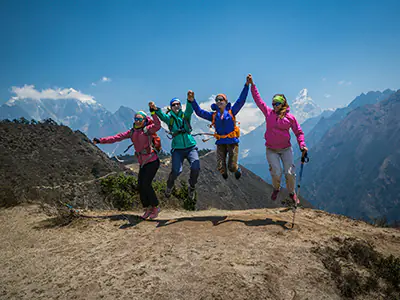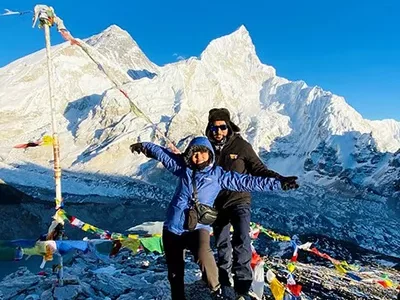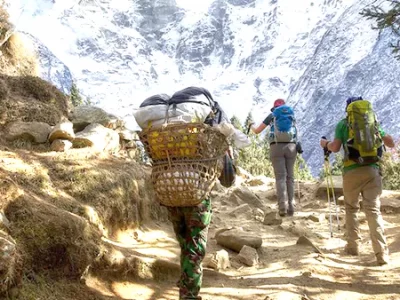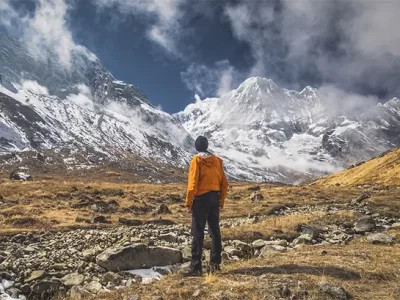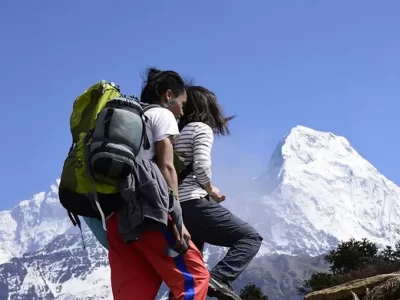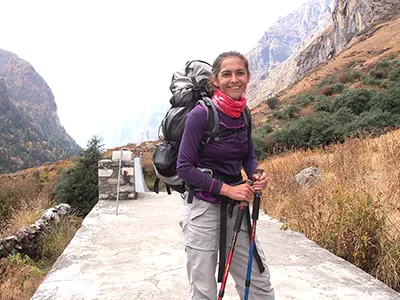Nepal offers breathtaking trekking routes, catering to all levels of trekkers. The best trek in Nepal for beginners provides stunning scenery and manageable trails, ensuring an unforgettable experience without being overwhelming.
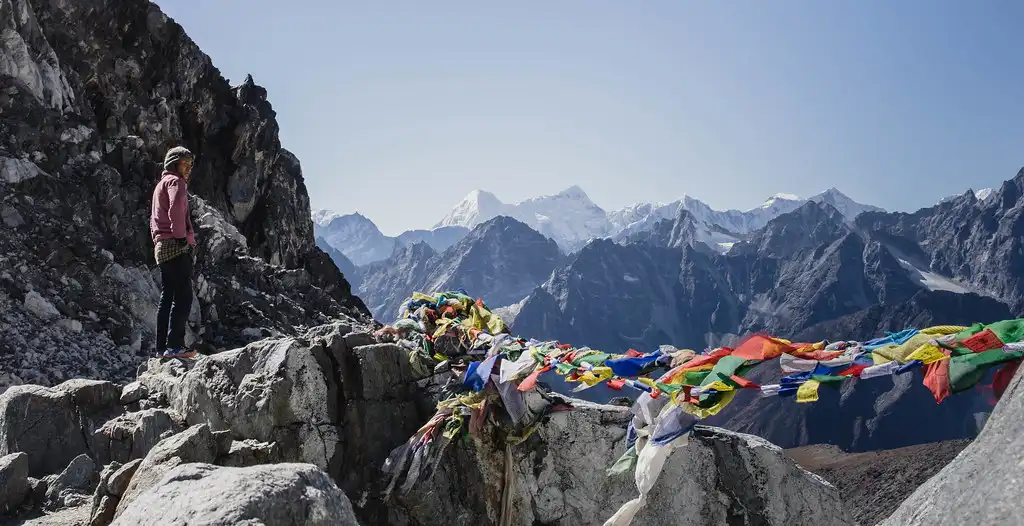
Choosing the right trek is crucial for beginners. Everest Base Camp for beginners presents both challenges and rewards. This trek allows you to see the world’s highest peak up close, making it a popular choice.
Other easy treks for beginners include the Ghorepani Poon Hill Trek and Langtang Valley Trek. These routes offer beautiful views and cultural experiences without the extreme altitude of Everest. For those seeking a varied trek for beginners, Annapurna Base Camp showcases diverse landscapes and stands as another excellent beginner trek.
Everest Base Camp Trek for Beginners
Everest Base Camp Trek
Everest View Trek
Why Nepal is Ideal for Beginner Trekkers
Nepal attracts beginner trekkers with its diverse trekking routes. The best trekking in Nepal for beginners features various landscapes, from lush forests to snow-capped peaks. This variety allows new trekkers to find trails that match their preferences and fitness levels.
The friendly local communities significantly enhance the trekking experience. Nepali hospitality stands out, and trekkers often form meaningful connections with locals. These interactions provide cultural insights and support, making the trek more enjoyable and less intimidating for beginners.
Well-marked trails and excellent infrastructure make trekking in Nepal accessible. Clear signage, established paths, and available accommodations ensure that even new trekkers can navigate the routes confidently. This well-developed infrastructure lets beginners focus on the experience rather than logistical challenges.
Top Treks in Nepal for Beginners
1. Ghorepani Poon Hill Trek
The Ghorepani Poon Hill Trek takes you through scenic paddy fields, rocky hills, and snow-covered mountains. Also known as the Annapurna Panorama trek, it suits those who want a relaxed trek, spend time with family, and enjoy close-up views of famous peaks.
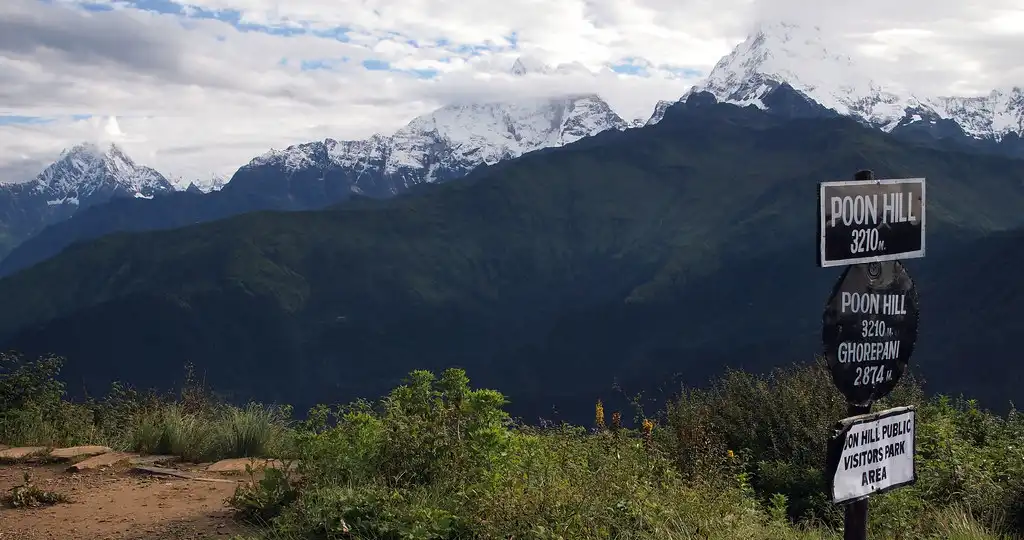
This trek is especially enjoyable with close friends or as a couple, as it takes you through the central part of Nepal, just north of Pokhara.
Highlights
- A short trek starting from Pokhara, a beautiful valley
- Completing the trek within two days from Pokhara
- Majestic views of Mount Annapurna I, Annapurna South, Dhaulagiri, and more
- The best Himalayan viewpoint in Asia
- Gateway to Annapurna Base Camp, Mardi Himal, and Khayer Lake
It offers a rich Himalayan experience and introduces you to the diverse lifestyles and traditions of the Tamang, Buddhist, and Thakali communities. Major peaks like Dhaulagiri (8167m), Annapurna I (8091m), Machapuchare (6993m), and Manaslu (8157m) capture your attention as you trek through the ever-changing terrain. You can extend this trek to the Annapurna Base Camp, Mardi Himal, or Khopra Ridge and Khayer Lake.
Duration and Difficulty
Trekking in Ghorepani Poon Hill, which is one of the easier treks to do in Nepal, can take about a week or less. You can take a plane from Kathmandu to Pokhara and then take a car to Nayapul. Start trekking from Nayapul to Tikhedhunga, then Ghorepani, Poon Hill, Tadapani, and back up to Nayapul before returning to Pokhara by road, where a plane can bring you back to Kathmandu.
This trek is relatively easy compared to higher-altitude treks. However, it includes a steep climb on day four, with 3,381 steps from Tikhedhunga to Ghorepani, gaining 1,387 meters in altitude in a single day. People with average fitness levels can complete this trek, adjusting daily trekking durations based on their pace.
You can trek this route year-round, but the best seasons are spring (March to June) and autumn (September to November), offering the most pleasant weather and best views, making it ideal for beginners.
2. Langtang Valley Trek
Trekking through Langtang Valley takes you through a variety of landscapes. Start in the lower reaches of the Langtang Valley and pass through small villages, farmlands, and dense forests until you reach the town of Kyanjin Gompa.
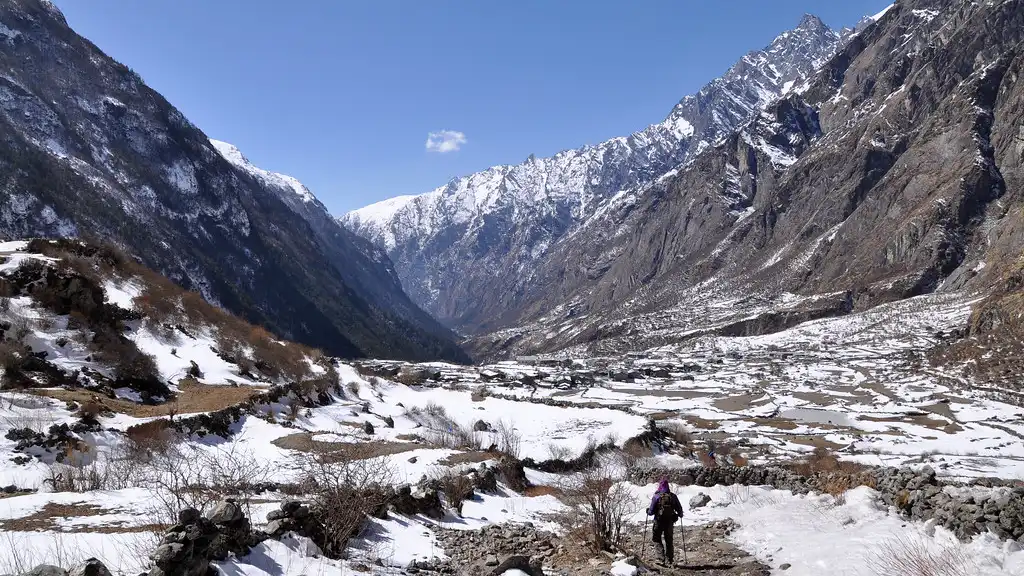
On the way, you walk under Langtang Lirung Ri, the source of the Trishuli River. The road offers panoramic views of the Langtang Mountains and peaceful evenings at the base of the towering Langtang Lirung.
Highlights
- Trek through Langtang Valley’s beautiful streams, creeks, and lush flora.
- Experience the spiritual atmosphere of Kyanjin Gompa.
- Enjoy an adventurous bus ride from Kathmandu to Syabrubesi.
- Explore the rich historical and cultural heritage of the Tamang and Sherpa communities.
- Ascend to the Tserko Ri summit for spectacular views of Dhaulagiri, Annapurna, and Ganesh Himal ranges.
- Discover the alpine wildlife and natural beauty of Langtang National Park.
This tour introduces you to the rich culture and traditions of the indigenous Tibetan people of the area. There are teahouses in the villages along the way where you can enjoy some of the best Tibetan food. The walk up from the Lama Lodge is more challenging, but the beauty of Langtang Valley makes the effort worthwhile. The trek ends at Kyanjin Gompa, where you can feel the peaceful spiritual glow and enjoy the scenery as you climb Mount Tserko Ri.
Duration and Difficulty
The Langtang Valley Trek lasts about ten days, making it ideal for beginners seeking a moderate trek. It starts with a bus ride from Kathmandu to Syabrubesi, followed by trekking to Lama Hotel, Mundu, Langtang, and Kyanjin Gompa, with an optional trek to Tserko Ri. The return trek follows the same path back to Syabrubesi and concludes with a bus ride to Kathmandu.
This easy-to-moderate trek features a gradual ascent for acclimatization. The highest point is Tserko Ri at 5,000 meters, while Kyanjin Gompa is at 3,870 meters. Trekkers do not need prior mountaineering experience. Well-marked trails and available accommodations ensure comfort, providing a balanced blend of scenic beauty and cultural experiences.
Annapurna Base Camp Trek
Ghorepani Poon Hill Trek
Langtang Valley Trek
3. Everest Base Camp for Beginners
The Everest Base Camp for Beginners trek suits those without prior trekking experience and those seeking a manageable yet unforgettable adventure in the Everest region. Perfect for first-time trekkers, this adventure trek blends spectacular beauty, rich culture, and attainable challenges.
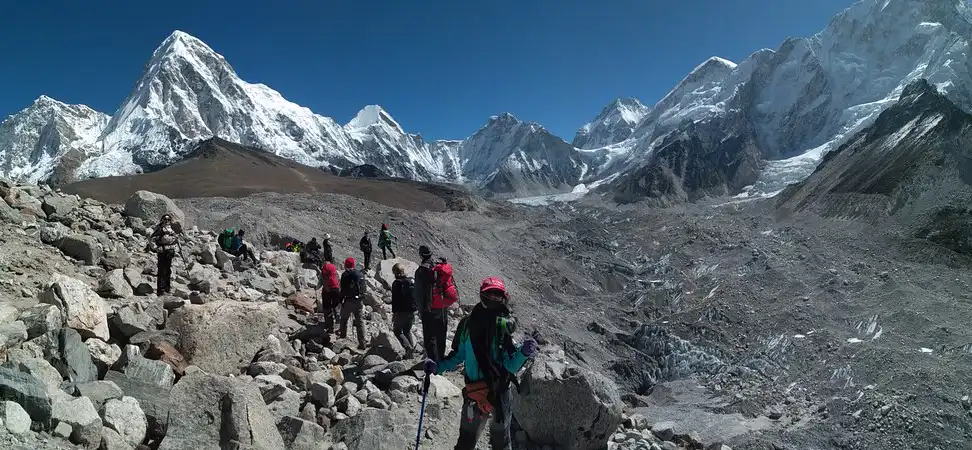
The trek includes days of acclimatization to reduce the risk of altitude sickness by assisting your body in getting used to height. Competent guides will accompany you during the trek, thereby keeping you safe and offering important information on matters concerning local customs and the environment. The trek features comfortable accommodations and hearty meals at each stop, allowing you to rest and rejuvenate after each day’s trek.
Highlights
- Make your way to Everest Base Camp, the legendary starting point for climbers aiming to conquer the world’s highest peak.
- Go to the summit of Kalapattha for spectacular sunrise views of Everest, Nuptsey, and the surrounding Himalayan giants.
- Experience the vibrant atmosphere of Namche Bazaar, the Sherpa capital, and immerse yourself in the rich mountain culture.
- Walk through picturesque villages and green landscapes and encounter breathtaking views of hills, glaciers, and snow-capped mountains.
- Complete the trek with an exhilarating helicopter flight from Gorakshep to Kathmandu, which offers breathtaking birds-eye views of the Himalayan landscape.
- Make lifelong memories by conquering challenging trails, experiencing breathtaking sights, and soaking in the majesty of Everest.
The itinerary incorporates moderate trekking days with sufficient breaks, making the experience more enjoyable and less strenuous for beginners. The highlight of the trek, reaching Everest Base Camp and witnessing the sunrise from Kala Patthar, offers a rewarding experience that is both achievable and awe-inspiring for first-time trekkers.
Duration and Difficulty
The Everest Base Camp Trek for beginners lasts 17 days, allowing ample time for acclimatization and rest. You start with a scenic flight from Kathmandu to Lukla, then trek to Phakding, Monjo, and Namche Bazaar. The route continues through Phungi Thanga, Debuche, and Somare, eventually reaching Dingboche for further acclimatization.
From Dingboche, you ascend to Dughla, Lobuche, and finally Gorak Shep. An early morning trek to Kala Patthar provides stunning sunrise views before you reach Everest Base Camp. The trek concludes with a scenic helicopter flight back to Kathmandu.
This moderate to challenging trek requires good physical fitness and mental preparation. Although prior trekking experience is optional, you should be ready for long walks on uneven terrain, steep inclines, and rocky paths. The highest point is Kala Patthar at 5,545 meters, with Everest Base Camp at 5,364 meters. Proper acclimatization, maintaining a steady pace, staying hydrated, and listening to your body are essential for success.
4. Everest View Trek
The Everest View Trek gives you the chance to appreciate Mount Everest without the stress of a long trek.
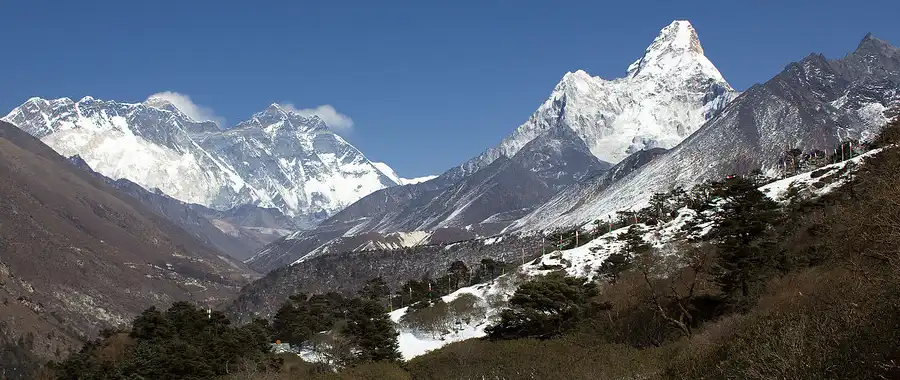
Start with a scenic flight from Kathmandu to Lukla, pass through Sherpa villages like Phakding and Monjo, and reach Namche Bazaar to experience climate change. Highlights include a visit to Tengboche Monastery, which offers breathtaking views of Everest and other peaks.
Highlights
- Scenic flight to Lukla with stunning mountain views.
- Exploration of Sagarmatha National Park, a UNESCO World Heritage site.
- Immersion in Sherpa culture at Namche Bazaar.
- Visit the ancient Tengboche Monastery, which has panoramic views of Everest and other peaks.
- Encounters with wildlife such as musk deer and Himalayan Monal.
This trek passes through the UNESCO World Heritage Site and Sagarmatha National Park, showcasing a variety of flora and fauna, including musk deer and Himalayan monal. Colorful rhododendron forests and tranquil lakes add to the natural beauty of this relaxing mini trek.
Duration and Difficulty
The Everest View Trek spans 9-10 days. You start with a flight from Kathmandu to Lukla and then trek to Phakding, Monjo, Namche Bazaar, and Tengboche. Tengboche, at 3,867 meters, marks the highest point. You return by following the same path back to Lukla and then fly back to Kathmandu.
This trek, considered easy to moderate, suits and fits trekkers of all levels. It avoids extreme altitudes and long durations, reducing the risk of altitude sickness. With well-marked trails and comfortable accommodations, this trek offers a relaxing and enjoyable way to explore the Everest region with less physical demand.
5. Annapurna Base Camp Trek
The Annapurna Base Camp Trek takes you through diverse flora and fauna, rich Gurung culture, terraced fields, and towering mountains.
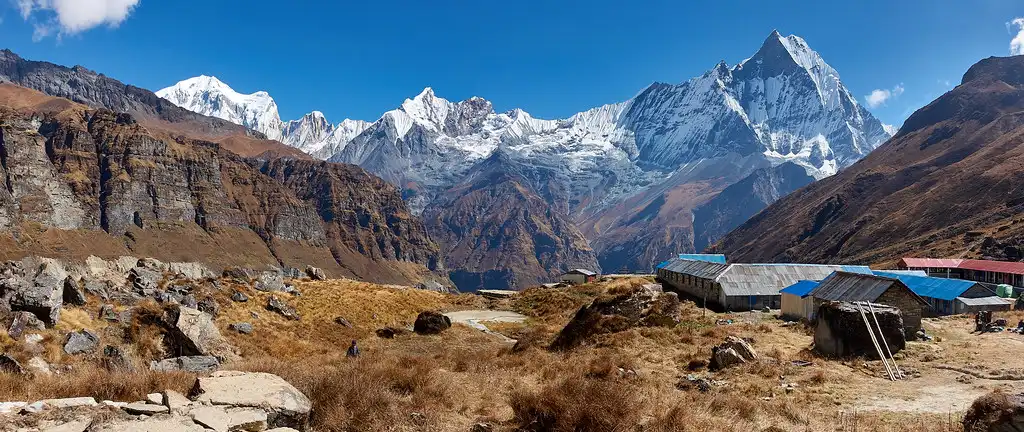
Trekkers enjoy a stunning panoramic view of nearly 11 snow-clad mountain peaks, providing a visual treat for tourists worldwide. Also known as the Annapurna Sanctuary Trek, it leads you through lush green rhododendron forests and the beautiful Annapurna Sanctuary.
Highlights
- Trek through Gurung hamlets and discover Western Nepal’s history and culture.
- Experience the stunning views of Machhapuchhre, Hiunchuli, Dhampus, and Dhaulagiri.
- Admire the spectacular dawn from Poon Hill while enjoying the view of Pokhara and the Annapurna region.
- Explore the alpine biodiversity while entering the Annapurna Conservation Area.
- Enjoy scenic streams and rhododendron blooms throughout the trekking trail.
- Relax in the natural hot spring at Jhinu Dada.
The trek starts from Pokhara, Nepal’s most visited place, offering natural wonders like lakes, mountains, gorges, and short treks. This trek is globally popular and listed as a must-visit destination on many travel websites. The trek allows global trekkers with limited time to reach the base camp of the spectacular Annapurna Mountain.
Key attractions of the Annapurna Base Camp Trek include trekking through Gurung hamlets, exploring Western Nepal’s history and culture, and experiencing stunning views of Machhapuchhre, Hiunchuli, Dhampus, and Dhaulagiri. You can admire the spectacular dawn from Poon Hill while enjoying views of Pokhara and the Annapurna region. The trek also lets you explore the alpine biodiversity in the Annapurna Conservation Area and enjoy scenic streams and rhododendron blooms throughout the trail. A natural hot spring at Jhinu Dada serves as another major draw for trekkers.
Duration and Difficulty
The ABC Trekking lasts around 10-14 days. You start with a drive from Kathmandu to Pokhara, then trek from Nayapul to Ghandruk, Chhomrong, Bamboo, Deurali, and Annapurna Base Camp. The return follows the same route back to Pokhara and concludes with a drive to Kathmandu.
This trek is easy to moderate, reaching a maximum altitude of 4,130 meters. You do not need rigorous mountaineering experience, but some stretches involve steady climbs and descents, requiring good physical stamina. Trekkers walk 4-7 hours daily, with acclimatization days included. The best seasons are spring and autumn, offering pleasant weather and spectacular views.
Choosing the Right Trek for Best Trek in Nepal for Beginners
When comparing these treks, consider your fitness level, available time, and personal interests. Everest Base Camp for Beginners presents a challenging trek that requires good physical fitness and spans about 17 days. It suits those seeking a rigorous adventure and an in-depth experience of the Everest region and Sherpa culture. Conversely, the Annapurna Base Camp Trek takes 10 – 14 days and has a moderate difficulty level suitable for people with average physical strength.
Besides, it is known for its varied geographical features, cultural interactions with Gurung and Magar communities, and geographic features such as hot springs. For those with shorter time or lower fitness levels, the Ghorepani Poon Hill Trek offers the best option. Perfect for beginners or those who want a short but rewarding trip with beautiful scenery and excellent photo opportunities. By considering these factors, you can choose the tour that best suits your needs to have a memorable travel experience in Nepal.
Why Choose Nepal for Your First Trekking Adventure
1. Diverse Trekking Options
Nepal offers a wide range of travel opportunities that are suitable for a variety of experiences, making it perfect for first-time visitors. You can choose from gentle walks through open landscapes to more challenging trails through steeper terrain.
Everest Base Camp Trek, Annapurna Circuit, and Langtang Valley Trek are all popular treks because they provide differing but unique difficulties as well as experiences. For beginners looking for the best treks in Nepal, Ghorepani Poon Mountain Trek is a good choice; it balances vulnerability with exotic locations for a rewarding first-time travel experience.
2. Stunning Scenery
Nepal’s dramatic landscapes feature some of the world’s most stunning scenery. The country’s diverse geography includes green terraced villages, dense forests, towering snowy peaks, and icy glaciers. Trekkers can enjoy breathtaking views of iconic mountains like Mount Everest, Annapurna, and Dhaulagiri. Whether you choose a short trek or an extensive expedition, each step promises unparalleled panoramic views, making the experience truly worthwhile.
3. Rich Culture
In Nepal, trekking involves physical adventure and cultural immersion. Villages and communities form part of the path where you can meet people from these areas, thereby knowing the way they live and their traditions.
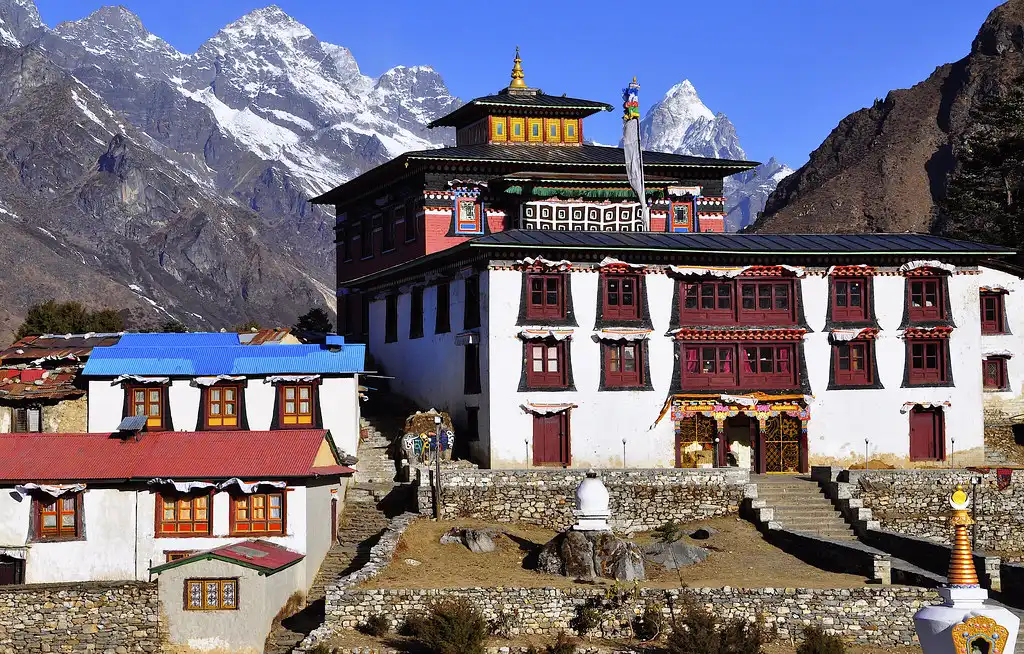
The trekking experience is further enriched and given meaning by the friendliness and welcoming nature shown by locals. The educational aspect of every trek arises from the daily practices as well as festivals that you will visit monasteries celebrating while watching ordinary happenings there, which makes each trek spiritually fulfilling.
4. Affordable Adventure
Nepal offers exceptional trekking experiences that are also cost-effective compared to other popular trekking destinations worldwide. Trekking permits, guides, porters, and accommodation are reasonably priced, allowing budget-conscious adventurers to enjoy a trip that might be unattainable elsewhere. The variety of treks available ensures options to suit various budget levels, making the best trek in Nepal for beginners an affordable adventure.
Preparing for Your Trek
1. Get the Right Gear
Having the right gear is essential to a successful trek. Invest in good hiking shoes, and break them in before you travel. Include an absorbent base, waterproof mid-layer, and waterproof outer when packing layers of clothing to adjust to changing weather conditions.
The essential features are a comfortable backpack, hiking poles, a hat, gloves, sunglasses, and a quality sleeping bag. Also, could you bring your supplies, such as a first aid kit, sunscreen, water purification kit, toiletries, and snacks? With the right equipment, you can make the best trips in Nepal enjoyable and comfortable for beginners.
2. Physical Fitness
Prepare physically to tackle the challenges of trekking. Start a fitness regimen at least two to three months before your trek. Focus on cardiovascular exercises like running, cycling, and swimming to build stamina.
Strength training, especially for your legs, will help with the long hours of walking. Include treks on varied terrain to simulate trekking conditions. A balanced workout that includes flexibility and balance exercises will reduce the risk of injuries and ensure you are well-prepared for the best trek in Nepal for beginners.
3. Acclimatization
Acclimatize properly to avoid altitude sickness, especially on higher-altitude treks. Plan your trip with adequate practice days so your body can slowly adjust to the thin air. Stay hydrated by climbing slowly and drinking plenty of water.
Avoid alcohol and eat a high-carbohydrate diet. Recognize symptoms of altitude sickness, such as headaches, nausea, and dizziness, and prepare to descend if necessary. Suitable weather conditions will help beginners safely enjoy the best trekking in Nepal.
4. Permits and Documentation
Obtain specific permits for trekking in Nepal. For most treks, you need the Trekkers’ Information Management System (TIMS) card and permits for conservation areas or national parks, like the Annapurna Conservation Area Permit (ACAP) or Sagarmatha National Park Permit.
Get these permits in Kathmandu or Pokhara. Ensure you have the necessary documents, including passport-sized photos and copies of your passport. With the correct permits and documentation, you can ensure a smooth experience on the best trek in Nepal for beginners.
5. Travel Insurance
Get proper travel insurance for any trekking adventure. Make sure your policy covers high-altitude trekking – including emergency medical expenses, evacuation, trip cancellation, and lost or damaged luggage.
Please make certain that it goes up to the highest point you expect to reach on your trek. Traveling with good insurance gives peace of mind and safeguards from possible hazards, thereby making the best trek in Nepal for beginners an absolutely safe and carefree experience.
Trekking Tips for Beginners
Trekking your path is important. Avoid feeling pressure to match the speed of faster pedestrians; Instead, go at a comfortable pace when climbing, especially at high altitudes. Staying hydrated and thriving is also important. Carry a reusable water bottle and drink often to maintain your energy levels and help acclimatize while eating a healthy, balanced diet.
Light packaging is important. Bring only essentials in your backpack to reduce shoulder weight. Pay close attention to your body if you have symptoms of mountain sickness, such as headaches, nausea, and dizziness. If you notice these symptoms, notify your guide immediately and prepare to descend if necessary. Himalayan weather can be unpredictable, so always carry layers and weatherproof gear to stay comfortable. Respect local culture by paying attention to regional traditions and customs, and always ask permission before photographing people, their homes, or places of worship.
Follow Leave No Trace guidelines to minimize your impact on the environment. Collect all trash, manage fire, and respect the ecosystem. Stay at the tea houses along the walkways for a relaxing break and a contribution to the local economy. Talk to the guide or other trekkers to let them know about the weather and road conditions. Finally, enjoy the experience. Remember that walking is as much about the trek as it is about the destination. Take time to appreciate the amazing surroundings, interact with the locals, and enjoy the moment.
Dealing with Altitude Sickness
Everyone can experience altitude sickness, regardless of fitness level. It’s important to recognize and respond to the symptoms promptly. Common symptoms include headaches, nausea, dizziness, and shortness of breath.
To reduce the risks, acclimatize gradually by including rest days in your schedule, especially when ascending to higher elevations. This approach allows your body to adjust to lower oxygen levels. Staying hydrated is essential, as dehydration can worsen altitude sickness.
Many trekkers carry acetazolamide-based medications like Diamox to prevent or treat altitude sickness. Please always consult your doctor before you take any medication. If symptoms worsen or do not improve with rest, the best course of action is to descend to a lower altitude. Prioritize your safety by descending to ensure your well-being.
When to Go Trekking in Nepal as a Beginner
Many adventurers aspire to trek in Nepal, and for beginners, timing is crucial for a safe and enjoyable experience. Nepal’s diverse landscapes and varying weather conditions create distinct trekking seasons, each with its pros and cons. Here is a detailed guide on when beginners should consider trekking in Nepal:
Spring Season (March to May): Spring offers clear skies and moderate temperatures, making it one of the best seasons for trekking in Nepal. The warming weather and blooming rhododendrons add vibrant colors to the surroundings.
Firm and dry trails make trekking more comfortable for beginners. Clear weather provides stunning views of the Himalayan peaks, enhancing the overall experience.
Popular choices for the best trek in Nepal for beginners during spring include Ghorepani Poon Hill, Langtang Valley, and Everest View Trek.
Autumn Season (September to November): Autumn, with its stable weather, bright skies, and pleasant temperatures, is considered the best trekking season in Nepal. We highly recommend this season for trekking.
Well-marked trails offer ideal walking conditions for beginner trekkers, with minimal rain. The crisp, clear air provides stunning mountain views.
In autumn, beginners can enjoy treks like Annapurna Base Camp, Dhampus Village Trek, and Langtang Valley Trek, which attract many trekkers due to favorable conditions.
Monsoon Season (June to August): The monsoon season brings heavy rainfall, making trekking challenging for beginners. Muddy trails and frequent rain can affect visibility.
We do not recommend monsoon trekking for beginners due to slippery trails, leeches, and landslide risks. However, rain-shadow areas like Upper Mustang and Dolpo remain relatively dry and suitable for trekking.
Beginners can explore cultural heritage sites in Kathmandu and Pokhara or engage in activities like white-water rafting during the monsoon season.
Winter Season (December to February): Winter brings cold temperatures and occasional snowfall at higher altitudes, while lower altitudes enjoy bright days and clear skies.
Winter allows trekking in lower altitude areas such as Ghorepani Poon Hill and Helambu. However, some trails may be icy, requiring caution.
Beginners can explore short treks in lower altitude regions, visit wildlife reserves, or participate in cultural tours during the winter season.
Packing Essentials
- Backpack: Choose a comfortable, reliable backpack that fits well and evenly distributes weight.
- Hiking Boots: Invest in sturdy, waterproof, and comfortable trekking boots.
- Clothing: Layer your clothing to adapt to changing temperatures. Include moisture-wicking base layers, insulating mid-layers, and waterproof outer layers.
- Sleeping Bag: Pack a robust sleeping bag suitable for cold conditions, especially for teahouse treks.
- Toiletries: Include essentials like a small towel, soap, and toilet paper.
- Trekking Poles: These provide stability and support, particularly on downhill paths.
- Headlamp: Useful for early morning or late evening treks and poorly lit lodges.
- Snacks: Carry energy bars, nuts, and other portable snacks to maintain energy during the trek.
- Cash: Bring sufficient cash, as ATMs are scarce in remote trekking areas.
Conclusion
As a beginner planning a trek in Nepal, I know it can be both exciting and rewarding. Equip yourself with the right gear, prepare physically, and understand the best trekking seasons to ensure a successful adventure. Remember to pack light, stay hydrated, and acclimatize properly for a safe and enjoyable trek. Selecting the best trek in Nepal for beginners will greatly enhance your experience.
Please develop an itinerary for your trek using the useful hints and data given. You should be kind to customs and appreciate every minute of wonderful views and unforgettable events from Nepal. When you mindfully prepare and view things positively, it becomes possible to have everlasting memories during your walking travel. The top roaming for starters in Nepal will be there, promising to give a lifetime expedition.

